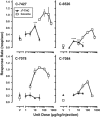Behavioral Determinants of Cannabinoid Self-Administration in Old World Monkeys
- PMID: 28059083
- PMCID: PMC5436120
- DOI: 10.1038/npp.2017.2
Behavioral Determinants of Cannabinoid Self-Administration in Old World Monkeys
Abstract
Reinforcing effects of Δ9-tetrahydrocannabinol (THC), the primary active ingredient in marijuana, as assessed with self-administration (SA), has only been established in New World primates (squirrel monkeys). The objective of this study was to investigate some experimental factors that may enhance intravenous SA of THC and the cannabinoid receptor (CBR) agonist CP 55 940 in Old World monkeys (rhesus and cynomolgus), a species that has been used extensively in biomedical research. In one experiment, male rhesus monkeys (N=9) were trained to respond under a fixed-ratio 10 schedule of food presentation. The effects of CP 55 940 (1.0-10 μg/kg, i.v.) and THC (3.0-300 μg/kg, i.v.) on food-maintained responding and body temperature were determined in these subjects prior to giving them access to self-administer each drug. Both drugs dose-dependently decreased food-maintained responding. CP 55 940 (0.001-3.0 μg/kg) functioned as a reinforcer in three monkeys, whereas THC (0.01-10 μg/kg) did not have reinforcing effects in any subject. CP 55 940 was least potent to decrease food-maintained responding in the monkeys in which CP 55 940 functioned as a reinforcer. Next, THC was administered daily to monkeys until tolerance developed to rate-decreasing effects. When THC SA was reexamined, it functioned as a reinforcer in three monkeys. In a group of cocaine-experienced male cynomolgus monkeys (N=4), THC SA was examined under a second-order schedule of reinforcement; THC functioned as reinforcer in two monkeys. These data suggest that SA of CBR agonists may be relatively independent of their rate-decreasing effects in Old World monkeys. Understanding individual differences in vulnerability to THC SA may lead to novel treatment strategies for marijuana abuse.
Figures



References
-
- Azofeifa A, Mattson ME, Schauer G, McAfee T, Grant A, Lyerla R (2016). National estimates of marijuana use and related indicators — National Survey on Drug Use and Health, United States, 2002–2014. MMWR Surveill Summ 65: 1–25. - PubMed
-
- Beardsley PM, Balster RL, Harris LS (1986). Dependence on tetrahydrocannabinol in rhesus monkeys. J Pharmacol Exp Ther 239: 311–319. - PubMed
-
- Carney JM, Uwaydah IM, Balster RL (1977). Evaluation of a suspension system for intravenous self-administration of water insoluble substances in the rhesus monkey. Pharmacol Biochem Behav 7: 357–364. - PubMed
-
- Dewey WL, McMillan DE, Harris LS, Turk RF (1973). Distribution of radioactivity in brain of tolerant and nontolerant pigeons treated with 3H-Δ9-tetrahydrocannabinol. Biochem Pharmacol 22: 399–405. - PubMed
-
- Fan F, Compton DR, Ward S, Melvin L, Martin BR (1994). Development of cross- tolerance between delta 9-tetrahydrocannabinol, CP 55,940 and WIN 55,212. J Pharmacol Exp Ther 271: 1383–1390. - PubMed
MeSH terms
Substances
Grants and funding
LinkOut - more resources
Full Text Sources
Other Literature Sources
Miscellaneous

